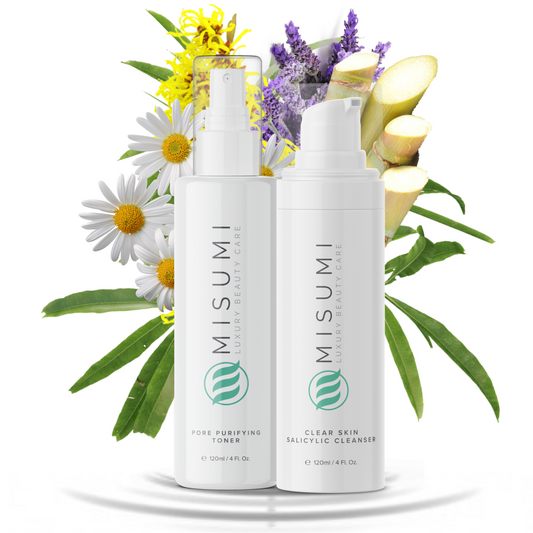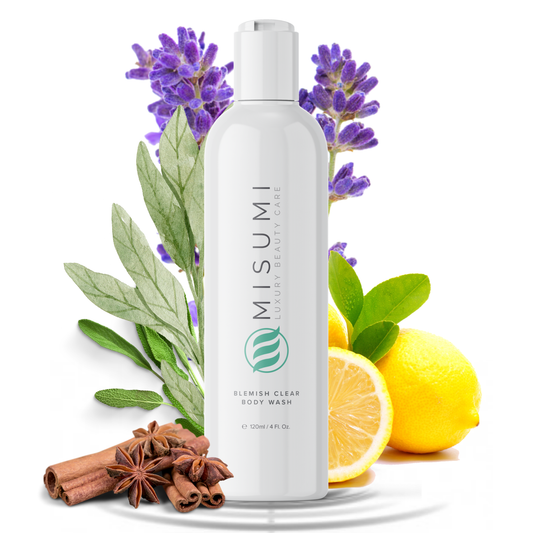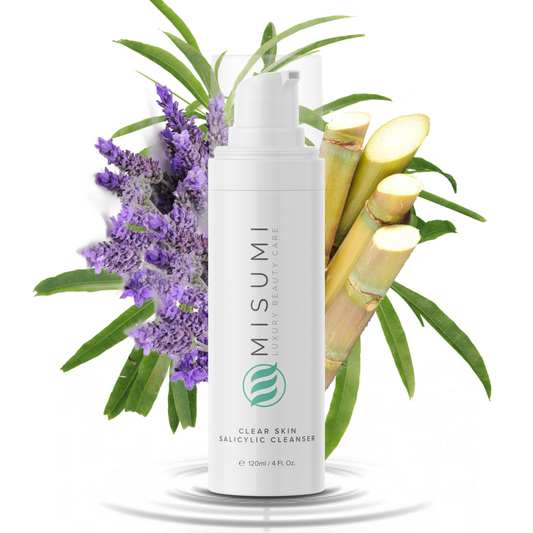You probably already own some cosmetic products that contain shea butter inside. From lip balms to body lotions, it's widely used in the beauty world for its moisturizing and calming properties.
Some people even swear by it as an acne treatment, but is that true? Can shea butter truly help to get rid of acne? We've got all the answers.
Let's explore the benefits of shea butter when it comes to breakouts and other skin conditions.

What Exactly is Shea Butter?
Pure shea butter is an extract from the African shea tree. You'll find it in shea tree nuts. It can be used as a skincare product in the cosmetic industry and as a cooking oil.
Africans have been using the miracle of unrefined shea butter for thousands of years for various purposes, including skin care. As a natural moisturizer, it keeps the skin and hair healthy and can even help with a range of skin conditions. Since it contains essential fatty acids and high amounts of vitamins A, F, and E, it's said to have a healing and regenerating effect on the skin.
Types of Shea Butter
There are a few types of shea butter on the market: refined shea butter, unrefined shea butter, and ultra-refined shea butter. You might be wondering what the difference is. They differ in how much they're refined, their texture and color, and how good they are for the skin. If you have sensitive or acne-prone skin, the best type of shea butter you can use is unrefined.
Unrefined Shea Butter
Unrefined shea butter is removed from its seeds by hand. The seeds are then boiled to make the shells simpler to remove. After they are boiled, they're broken so that the inner seed is gathered and then boiled to extract the fat. Finally, the fat is whipped, and the end product is raw shea butter.
Refined Shea Butter
Refined shea butter is processed using some chemicals that make the process easier. Any smell from the product is also removed at the end. When shea butter undergoes this process, some of its benefits are changed, making it less valuable for the skin.

Shea Butter Benefits
Due to its high vitamin content, shea butter (in its pure form) is said to repair the skin thoroughly. It forms a protective barrier over the skin, sheltering it from harmful influences like winds, cold weather, and pollution. It has anti-inflammatory and antioxidant properties, and it helps calm redness and irritation.
Shea butter also helps prevent the formation of wrinkles and fine lines. In addition to its anti-aging benefits, it naturally hydrates the skin. Since dry skin types are most prone to premature signs of aging, it makes sense that it would prevent those from occurring. Besides, it increases elastin and collagen production, making your skin look young in the long run.

Not to mention, it has a natural SPF of approximately 6, so it partly protects the skin against sun damage and harmful UV rays.
It seems like the list of benefits of shea butter goes on and on infinitely. It also contains a lot of triterpene alcohols, whose function is to help the oil delve deeper into the skin. They kill acne-causing bacteria and have anti-inflammatory benefits. On top of that, shea butter also unclogs the pores, cleanses the skin inside out, and relieves itchiness.
And if that wasn't enough, shea butter also helps prevent stretch marks from expanding.
How to Use Shea Butter to Treat Acne
If you want to treat a pimple topically or use shea butter for acne, purchase unrefined shea butter. Dip a cotton ball in it, and put it on your pimple. Leave it on your skin overnight and thoroughly wash it in the morning. You should notice that it has significantly shrunk the next day. Make sure that you apply it on a cleansed face.
If you're on the hunt for a natural face moisturizer, give shea butter a go! It can be used as a rejuvenating overnight face and under-eye cream. Apply shea butter all over your face and under your eyes, and you'll wake up the next day with softer, hydrated skin.
Assuming you enjoy a pamper day every once in a while, try out these shea butter face masks to add something extra to your self-care routine.
Honey and Shea Butter Face Mask
This anti-aging mask will make you fall in love with shea butter. Mix shea butter with a teaspoon of raw honey and add a few drops of almond oil. Combine the ingredients in a small bowl and apply the mixture on a clean face. Wait 20 minutes to an hour for the mask to settle, and then wash it off.
Shea and Lavender for Aggravated Skin

This mask is perfect for easing irritation, redness, and dry patches. Apply a few drops of lavender essential oil in a bowl and add a teaspoon of shea butter. Leave the mask on for 10 to 15 minutes before washing it off
Lavender oil is amazing for moisturizing, and its antimicrobial benefits will protect the skin from acne-causing bacteria. In addition, it also has many anti-inflammatory properties that heal and soothe irritated and injured skin.
Not a fan of lavender? No problem! There is a world of essential oils out there for you to peruse. Rose, helichrysum, and frankincense are all great essential oils for healing.
Shea and Oil Party
This mask combines some of the greatest and safest natural oils for treating acne-prone skin with shea butter. Add a few drops of pure jojoba oil, grapeseed oil, and argan oil to a tablespoon of shea butter and apply the mixture to your face. Leave it for about half an hour, then gently remove the excess using a washcloth. You can also leave it on overnight and wash it off in the morning.
This face mask is an amazing option for dry and sensitive skin. The oils mentioned aren't comedogenic, so they won't clog your pores. They're also high in vitamins and antioxidants and have anti-aging benefits. Your skin will look fresher and healthier than ever.
Does Shea Butter Work for Skin Discoloration?
Although unrefined shea butter is an excellent option for moisturizing and softening the skin, experts say it doesn't work well for discoloration and hyperpigmentation. Some people claim that there can be a slight improvement in terms of skin brightening four to six months after you start using it, but this is merely anecdotal evidence. Every skin type is different, so the reactions will vary.
So, even though you might not experience results immediately, or any at all, there is no harm in trying raw shea butter if you suffer from discoloration and dark spots.
Can Shea Butter Clog your Pores and Break You Out?
Sensitive skin types rejoice! Luckily, shea butter is considered 0 on the comedogenic scale, meaning there is little to no chance of it clogging your pores. And that is pretty impressive if you consider just how rich and buttery its texture is. Apply a thin layer to your skin, worry-free!
Which Skin Types is Shea Butter Suitable for?

As we've already established, unrefined shea butter is a non-comedogenic product, so people with acne-prone skin are safe to use it. It's incredibly moisturizing, so it's a perfect match for people suffering from dry skin.
Can Shea Butter Clog Pores?
When it comes to oily skin types, some might shy away from this product because of its consistency. Like coconut oil and other body butters, they fear it will add to the oil and mess with their pores.
So can shea butter clog pores? It's highly unlikely since non-comedogenic oils stop excess oil from emerging. They moisturize your face without making it look greasy.
It's safe to conclude that shea butter is suitable for all skin types, and everyone could benefit from it.
Can You Use Shea Butter for Acne Scars?
One of the most annoying side effects that come with acne is scarring. Scars take longer to heal, and the treatments are usually more expensive. So can you use shea butter for acne scars?
The answer is yes! Fortunately, shea butter can treat acne scars! Its ingredients prevent keloid scar tissue from forming. Since it's an incredible natural moisturizer, it also works well with acne treatments. It prevents scarring and reduces scar tissue swelling. It contains vitamin F and vitamin E oil, which are extremely anti-inflammatory and great for healing the skin and protecting it from free radicals.
As for those who already suffer from acne scars, the regular incorporation of shea butter in your skincare routine can reduce the size of the scars, but it will take much longer than other commercial treatments. You can look into lasers or chemical peels if you want faster results.
For a comprehensive guide on the best skincare tips for flawless skin, click here.
Is Shea Butter Safe to Use?
As with every product or ingredient, you should try a patch test before using shea butter or shea butter oil. Apply a small amount of shea butter to your face, and wait 24 hours. If you have a reaction, stop using this ingredient immediately.
Patch tests are the best way to minimize the risk of allergic reactions, and you should conduct one for every new product you use, whether that's an essential oil or even a face cleanser.
Combine Shea Butter With Effective Anti-Acne Treatments
Although raw shea butter works wonders for the skin, you might not see a difference in those acne breakouts straight away. You'll need effective skincare products to tackle the problem. Misumi's Complete Clear 3-Step System consists of a cleanser, toner, and moisturizer. This routine will get rid of dead skin cells, calm inflammation and irritated skin, and reduce breakouts.
Final Thoughts
There are no overt side effects of using shea butter. Even though shea butter is made from shea nuts, it's still generally safe for those who suffer from nut allergies. However, if you notice any breakouts, irritation, itching, or redness from applying shea butter, then stop using it immediately. It's wise to do a patch test before trying out this treatment.
Its shelf life is two years. The best type for acne-prone and oily skin is raw shea butter.
Shea butter works incredibly well as a moisturizer. It has diverse benefits – it softens the skin and makes it look younger, healthier, and brighter. As for acne, it can help moisturize the skin since overly dry skin can produce excess sebum.
Although it's probably not the best treatment option for acne scarring, some evidence suggests it can help prevent acne scars in the long run.
Unfortunately, it's not the quickest or most effective option for treating acne. But that doesn't mean you can't reap any benefits. Start introducing more shea butter into your life (and skin care routine) now!
FAQs
How long does shea butter take to clear acne?
Can shea butter clog pores? The answer is no! Shea butter will not clog your pores or make you break out. Shea butter is rated a 0 on the comedogenic scale, which means it's safe to use as an anti-acne treatment. So whether you're looking for a natural treatment to help acne, reduce acne scars, or just moisturize your oily skin, you're safe with shea butter.
However, keep an eye out when trying homemade skin care recipes containing shea butter. Some might have other moisturizing ingredients that may clog pores (such as olive oil). Recipes containing tea tree oil, rosehip oil, and neem oil are generally safe to use and will leave you with healthy skin.
Can shea butter make you break out?
Shea butter is not just good for the face! You can apply shea butter all over your body to rake in all that buttery goodness. Use shea butter on your arms, legs, hands, neck, and more to get the lovely soft skin you've always wanted.
Is it okay to put shea butter on your face?
Shea butter is safe to leave on your face overnight. The healing properties and anti-inflammatory properties of this natural remedy will help you if you suffer from very dry skin or acne and acne scars.
References
Anti-Inflammatory and Skin Barrier Repair Effects of Topical Application of Some Plant Oils
Skin acceptability of a cosmetic moisturizer formulation in female subjects with sensitive skin








